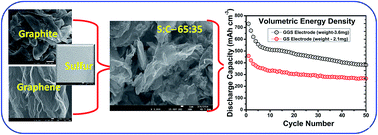Graphene-decorated graphite–sulfur composite as a high-tap-density electrode for Li–S batteries†
Abstract
Establishing the efficient electronic conductivity of a sulfur cathode without compromising the volumetric energy density and confining dissolved polysulfides within the cathode of the cell are first-order research priorities in the area of Li–S batteries. The emerging nanotechnology-based approaches, especially the use of porous nanocarbon in the formation of the sulfur electrode, stand to negatively affect the volumetric energy due to the low tap-density of C–S cathodes. In order to address these issues, we study the effects of the porosity and density of different carbons such as graphite, graphene and graphite–graphene hybrids on the overall volumetric capacity of the electrode. Although graphene–sulfur (GS) and graphene-decorated graphite–sulfur (GGS) electrodes show similar gravimetric capacities (~1050 mA h g−1), the GGS electrode exhibits a high volumetric capacity (745 mA h cm−3) without compromising the electrochemical stability over 50 cycles. Furthermore, an excellent cycle stability of the GGS electrode over 100 cycles is achieved by coating a thin layer of poly(methyl methacrylate) (PMMA) on the GGS electrode. Maintaining a high tap-density along with porosity is key in achieving high volumetric capacity in C–S cathodes.


 Please wait while we load your content...
Please wait while we load your content...